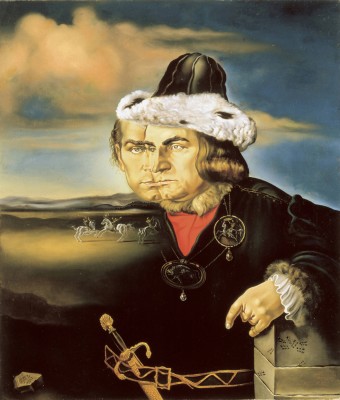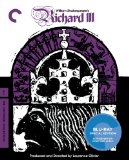| Reviews & Columns |
|
Reviews DVD TV on DVD Blu-ray 4K UHD International DVDs In Theaters Reviews by Studio Video Games Features Collector Series DVDs Easter Egg Database Interviews DVD Talk Radio Feature Articles Columns Anime Talk DVD Savant Horror DVDs The M.O.D. Squad Art House HD Talk Silent DVD
|
DVD Talk Forum |
|
|
| Resources |
|
DVD Price Search Customer Service #'s RCE Info Links |
|
Columns
|
|
|
Richard III (Criterion Collection)
Hamlet (1948), contrastingly photographed in moody black-and-white, is almost a film noir. Though Olivier controversially cut the four-hour play down to a more exhibitor-friendly two-and-a-half hours, it was a commercial and critical smash, winning four Academy Awards, including Best Picture and Best Actor (Olivier).
Richard III (1955), though well-regarded, received the least praise originally, though today many consider it Olivier's best and certainly one of his greatest screen performances. The movie was made in the super-sharp widescreen process VistaVision, and Olivier, very cognizant of its qualities, seems to have married his own visual concepts and staging with the process, maximizing its potential. Visually it embraces a classicism closer to Kenneth Branagh's 1996 film of Hamlet (itself filmed in super-sharp 65mm) rather than Olivier's Hamlet.
The results are classical and lush, though the bulk of the film's audience, seeing only standard 35mm reduction prints or, worse, as an ill-conceived simultaneous U.S. premiere on American network television (where 99% of the viewing audience would have experienced the color film in black-and-white) were largely denied much of what makes Richard III such a masterpiece.
However, this 2012 Film Foundation 4K restoration, from the original 8-perf VistaVision camera negative, this Richard III is a sumptuous viewing experience. Criterion's Blu-ray also includes many complimentary extra features, most notably a one-hour television interview with Olivier conducted by theater critic (and, at the time, Olivier critic-turned-collaborator) Kenneth Tynan.
Salvador Dali's painting, withheld by the Spanish government until it was too late to use it to promote the movie
Even as his older brother (Cedric Hardwicke) is crowned King of England, the malformed Richard, Duke of Gloucester (Laurence Olivier), is already plotting to usurp the throne. He frames his other brother, George, Duke of Clarence (John Gielgud) for a murder plot, and he's banished to the Tower of London. Edward, in failing health, issues a pardon for George but Richard intercepts it, and instead sends two ruffians (Michael Gough and Michael Ripper, roles originally intended for Richard Attenborough and John Mills) to murder George, drowning him in a butt of Malmsey. Meanwhile, Richard busies himself seducing Lady Anne (Claire Bloom), whose husband and father Richard had only recently murdered.
On his deathbed the King appoints Richard Lord Protector, and in league with his cousin, the devious Duke of Buckingham (Ralph Richardson), Richard methodically plots and murders his way to the throne.
I first saw Richard III about 20 years ago and my reaction then was not what I expected: I found it rather funny. That is, specifically, I found Olivier's uniquely eccentric performance darkly, drolly amusing. He had played the role on the British stage with great success in 1944 (in a production co-starring Ralph Richardson), this despite Donald Wolfit having played what was then regarded as the definitive interpretation only a short time before.
For the film version Olivier dialed back Richard's physical abnormalities, reducing the size of his hump, deemphasizing his limp and withered arm, and so on, while realigning Richard's delicious soliloquies with an eye on the intimacy afforded by the VistaVision camera. Rare for the time, during these soliloquies the Crookback King looks straight into the camera lens, sharing his innermost thoughts with the viewer, in turn rendering him more likeable and frightening at once.
Olivier's Richard is a marvel. On one hand the character has ice water in his veins. He's a unrepentant, cold-blooded murderer who, in contrast to, say, Macbeth, never gives a second thought to his evil deeds, while intimating a kind of sadistic pleasure with each arrest or murder. Olivier's clipped delivery (even for him) and strange, almost bird-like expressions and movements always struck me as wonderfully authentic (Olivier's submerges himself completely; unlike many other film performances, here his acting is all but invisible) but where does it come from, I wondered?
Olivier's 1966 interview with Kenneth Tynan provides the answer. He based the voice on old actors' imitations of Victorian thespian Henry Irving. (Irving, coincidentally, is said to have been the inspiration for Bram Stoker's Dracula.) He emphasized Richard's long black locks and nose partly to suggest a witch and a general femininity in his performance, while in his physical movements Olivier was inspired by a Broadway producer he loathed, Jed Harris, who had also inspired Walt Disney's Big Bad Wolf characterization in The Three Little Pigs.
The first three-quarters of the picture were photographed on large interior sets and equally lavish soundstage exteriors. However, for the climatic Battle of Bosworth Field Olivier took his cast and crew to Spain, a decidedly un-English looking countryside complete with a mountain range in the distance. Olivier tries to obscure some of this with clever use of matte paintings, but the effect only partially succeeds.
Olivier's staging for the camera, whether Richard is alone or surrounded by the Royal Court, is extremely imaginative, with both actors and the camera constantly repositioning themselves to underscore character relationships, shifting power, allegiances, etc.
This also serves to add dynamism to Olivier's frequent use of long, uninterrupted takes. Something I hadn't considered until Olivier brought it up in his interview with Tynan is that while ordinary 35mm film cameras would have allowed 10-minute takes (as was done in Alfred Hitchcock's Rope), VistaVision's horizontal, eight-perf frames effective cut this time in half, thereby requiring Olivier and his actors more precise timing (and on-set tension) during these reel-long takes.
The film was famous for the four knighted actors in its cast, Sirs Laurence Olivier, Cedric Hardwicke, Ralph Richardson, and John Gielgud, all of whom have substantial parts. Each had their own particular approach to acting Shakespeare, yet the film casts them in roles playing to their unique strengths. It's not the fascinating but uneven jumble of acting styles found in several of Kenneth Branagh's Shakespeare films, and plays more the unified work.
Disregarding the fact that much of Richard III's effectiveness depends on the clarity and color of its VistaVision presentation, U.S. distributor Lopert Pictures perversely opted to premiere it in theaters and on network television the very same day. The heavily promoted TV premiere, broadcast in color but at a time when color TVs cost as much as automobiles, it was seen by most in black-and-white on screens 12-inches or smaller. The film was a financial failure, thwarting Olivier's hopes to film Macbeth next, with then-wife Vivien Leigh as his co-star.
Video & Audio
Richard III was cut through the years, first for its U.S. release in 1956, and then again for a '60s reissue. The restoration restores the film to its original 158-minute running time. (Well, technically, less than three minutes shy of its 161-minute original release version, though it's not clear if the difference might consist of intermission cards and the like.) The restoration, funded by the Foreign Press Association and the Film Foundation, in association with the BFI, ITV, the Museum of Modern Art, and Romulus Films, is glorious. A small handful of footage lacks the extreme sharpness of the rest of the film, culled from the 1.66:1 VistaVision camera negative, but overall it looks amazingly good. The mono audio, sourced from an optical track print, is also excellent. The disc is Region A encoded.
Extra Features
Supplements include a very good, mostly literary reading of the film by playwright and stage director Russell Lees and former Royal Shakespeare Company governor John Wilders. Of more immediate interest is the aforementioned 1966 TV interview with Oliver and Kenneth Tynan, which covers Olivier's early career as well as the plays and films of Henry V, Hamlet, Richard III, and Othello (1965-66), all with illustrative (if black and white) video excerpts. An extensive gallery cleverly intersperses gorgeous behind-the-scenes stills and poster art with excerpts about Richard III from Olivier's 1986 autobiography, On Acting. Martin Scorsese hosts an excellent restoration demonstration, while in addition to a standard British theatrical trailer there's an odd, extended one apparently prepared for British television. That black and white film includes behind-the-scenes footage featuring members of the crew. Finally, a booklet essay by Amy Taubin sheds yet more light on the production.
Parting Thoughts
A peerless home video presentation of one of the all-time great Shakespeare films, Richard III is an absolute must, one of the year's best releases, and a DVD Talk Collector Series title.
Stuart Galbraith IV is a Kyoto-based film historian whose work includes film history books, DVD and Blu-ray audio commentaries and special features. Visit Stuart's Cine Blogarama here.
|
| Popular Reviews |
| Sponsored Links |
|
|
| Sponsored Links |
|
|
| Release List | Reviews | Shop | Newsletter | Forum | DVD Giveaways | Blu-Ray | Advertise |
|
Copyright 2024 DVDTalk.com All Rights Reserved. Legal Info, Privacy Policy, Terms of Use,
Manage Preferences,
Your Privacy Choices | |||||||














